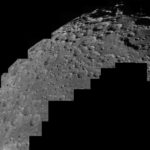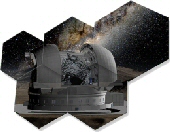Italian Language (for English, please read further down):
Vi presento l’ultima immagine frutto della sessione di imaging del 24 aprile scorso.
Come detto in precedenza (v. https://www.carmelozannelli.com/site/?p=1785 e https://www.carmelozannelli.com/site/?p=1780 ) le condizioni di stabilità atmosferica erano appena sufficienti alle riprese, effettuate sempre in compagnia dell’amico astrofilo Mario Lauriano.
L’immagine risultante è il frutto della somma di 15 immagini lunari (ciascuna a sua volta risultante dalla somma di circa 120 frames totali di ogni singolo filmato di circa 1200 frames) assemblate come un puzzle a formare l’unica immagine che, seguendo il bordo lunare, va dal terminatore (col cratere Tycho, sulla destra dell’immagine) a Clavius, poi Moretus, il Polo Sud lunare e ancora lungo il bordo del lembo Sud-Est, con una miriade di crateri e craterini fino all’estrema sinistra dell’immagine, coi crateri lavici Hanno-H, Jeans-S (quelli col fondo di colore più scuro, tipico dei mari lunari).
Le variazioni di seeing intercorse durante tutta la sessione di riprese (durata circa due ore) hanno influenzato la risoluzione raggiunta che, procedendo in senso antiorario, dalla ripresa del cratere Tycho, fino al bordo del lembo Sud-Est, è mano a mano diminuita anche per l’altezza lunare dall’orizzonte del sito di ripresa.
E’ affascinante muoversi lungo tutta l’immagine, aprendo l’immagine a piena risoluzione (quella originale scaturita dal rapporto Focale-Equivalente/Dimensione-pixel del sensore della telecamera) e andare letteralmente “a spasso per la Luna”, come se ci trovassimo in orbita sopra di essa.
Unica remora è stata la mancanza di alcuni pezzi del “Moon-Puzzle” dovuta al difettoso inseguimento (tracking lunare) della montatura equatoriale dello strumento, che andava preventivamente settata poichè non veniva usata da diverso tempo.
Grazie, come sempre, per la Vs. cortese attenzione e… ad maiora semper! 😉
Dettagli Tecnici:
Celestron C14 StarBright ad F/22 – Baader-Zeiss Abbe Barlow 2x – Baader R @ ~ 590 nm filter – GS3-U323S6M-C camera – Seeing max 6,5/10 @ 590nm band – sito: Palermo @ my personal Observatory.
English:
I present the last image of the Imaging session of April 24th.
As previously stated (see https://www.carmelozannelli.com/site/?p=1785 and
https://www.carmelozannelli.com/site/?p=1780) the conditions of the seeing were just enough to imaging, session always carried out with my friend Mario Lauriano.
The resulting image is the sum of the total of 15 lunar images (eachone from the stack of about 120 total frames of each single film of a total of about 1200 frames) assembled as a “puzzle” to form the only image that, following the edge lunar, goes from the terminator (with the crater Tycho, on the right of the image) to Clavius, Moretus, the Lunar South Pole and still along the edge of the South-East limb with a myriad of craters until the extreme left of the image, to the lava craters Hanno-h, Jeans-S (those with the bottom of darker color, like the lunar seas).
The variations of seeing spent throughout the shooting session (lasting about two hours) has influenced the resolution reached which, proceeding counterclockwise, from Tycho crater, up to the edge of the South-East limb, has also gradually decreased for the lunar height from the horizon of my shooting site (my personal observatory).
It is fascinating to move along the whole image, opening the image at full resolution (the original one resulting from the Focal-Equivalent / Pixel-size ratio of the camera sensor) and literally going “walking around the Moon”, as if we were there in orbit above it.
Only scruple was the lack of some pieces of the “Moon-Puzzle” due to the defective tracking (lunar tracking) of the equatorial mount of the instrument, which had to be set beforehand because it was not used for some time.
Thank you, for your kind attention and … ad maiora semper! 😉
Technical details:
Celestron C14 StarBright ad F/22 – Baader-Zeiss Abbe Barlow 2x – Baader R @ ~ 590 nm filter – GS3-U323S6M-C camera – Seeing max 6,5/10 @ 590nm band – site: Palermo @ my personal Observatory.


